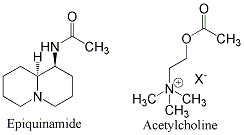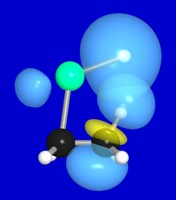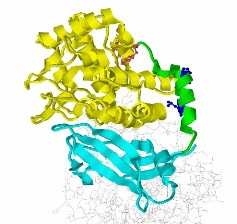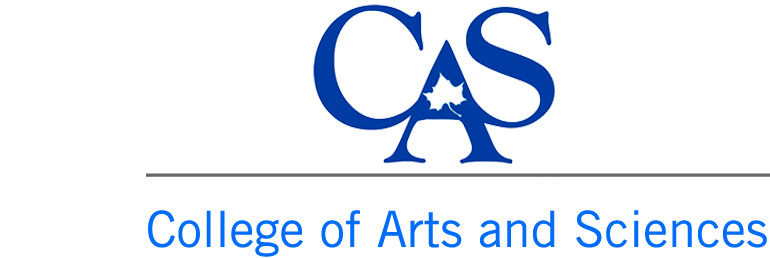Chemistry Research Projects
If you're interested in participating in one of the projects described below, talk to the faculty investigator.
Natural Products Chemistry (Fitch)

The work in my group involves the isolation, structure elucidation and synthesis of natural products. Most of this work centers around neuronal nicotinic acetylcholine receptors, which are important to fast synaptic transmission in the central nervous system. Dysfunction of these receptors has been implicated in a number of disease states, including Alzheimer's and Parkinson's diseases, Tourette's syndrome, Schizophrenia, and certain epilepsies. Projects in my group include isolation and identification of bioactive compounds from plants, including tobacco, Laburnum (golden chain tree), Kentucky Coffeetree and other legumes. Synthetic projects include enantioselective Swern oxidations and metal-mediated reactions, synthesis of natural products, such as epiquinamide, and medicinal chemistry of bioactive compounds for determining structure-activity relationships. While I take students at all levels, an understanding of organic chemistry is needed for the synthetic projects and thus preference will be given to those who have completed CHEM 351/352 with reasonable grades.
Biochemistry: Plant and Fungal Enzymes: Browning Reactions in Plants, Fruits, and Vegetables (Flurkey)
Browning reactions occur in plants, fruits, and vegetables just as they do in mammals and invertebrates. These reactions can lead to loss of nutritional quality and consumer appeal in fruits and vegetables. The enzymes responsible for these reactions include tyrosinase (polyphenoloxidase), laccase, and peroxidase. Tyrosinase exists in an inactive or latent form that can be converted into active forms under various conditions. We are currently examining the biochemical characteristics of the active and latent enzyme in order to understand their relation to browning. We are also examining forms of the enzyme that exist during mushroom development using isolelectric focusing and 2-D electrophoresis. Number of participants: one to three, preferably with an interest in biochemistry. Required background: interest in biochemistry, knowledge of organic chemistry. What the participants will learn: biochemical techniques associated with protein and enzyme characterization.
Computational Chemistry: Reactions of Small Organic Molecules on Metal Atoms (Glendening)

Metals promote a variety of insertion, rearrangement, and elimination reactions in organic systems. Though the products of these reactions can be identified in the laboratory, the mechanisms by which they are produced often remain unclear. We use computational chemistry methods to explore, in detail, reactions of small organic molecules on single transition metal atoms. We are particularly interested in understanding how the metal center influences the reaction. Recent attention has focused on the gas-phase reactions of acetylene, ethylene, and formaldehyde with neutral yttrium atoms. Comparison data are available from molecular beam experiments. The calculations reveal that the reactions are controlled by the insertion of metal atoms into C-H bonds. Number of participants: one to three, preferably chemistry majors, freshmen or higher. Required background: interest in computers. What the participants will learn: computational chemistry methods, high-level calculations with the Gaussian 98 and MOLPRO programs, the Linux operating system.
Bioinformatics (Inlow)

The field of bioinformatics centers around the computer-assisted analysis of molecular sequences (protein, DNA, RNA). Bioinformatics tools and techniques can be used to investigate biological questions relating to these sequences, with the goal of providing information and predictions to guide subsequent work by experimentalists. Our work focuses on structural bioinformatics problems, employing sequence analysis in order to predict protein structure and/or function. One project currently underway is the analysis and comparison of the amino acid sequences of the enzyme tyrosinase from a variety of species. Of particular interest are tyrosinases from plants and fungi. Number of participants: one to two undergraduate chemistry majors with an interest in biochemistry. Required background: knowledge of organic chemistry and introductory biology (knowledge of biochemistry is desirable but not essential). What the participants will learn: use of bioinformatics tools for sequence alignment, secondary structure prediction, protein structure visualization, prediction of protein posttranslational modification, and interpretation of results.
Miniature Instrumentation and Thermodynamic Aspects of Batteries (Noll)
In analytical chemistry, the development of portable scientific instruments to chemically analyze samples in the field, at a suspected site of pollutant contamination, could significantly speed the progress of environmental cleanup. Students selecting this project will be working with a small, commercially available instrument that can be used to detect possible chemical pollutants. Although portable, physically robust and inexpensive, the instrument is not very sensitive in detecting chemical compounds. We will be investigating the utility of methods, in the laboratory, to make the instrument more sensitive. Students interested in this project should be comfortable with working with chemicals in a laboratory setting and occasionally working with tools like wrenches and screwdrivers on small mechanical devices.
In physical chemistry, my current interests encompass thermodynamics and its application to battery systems. We are interested in thermally regenerative electrochemical cycles (TREC). Electrochemical cells (batteries) can be discharged at one temperature and, when depleted, their temperature can be changed, allowing the reverse reaction to become spontaneous with subsequent discharge at the higher temperature. The coupling of these cells to oscillating heat sources, such as, but not limited to, diurnal variations in sunlight, is contemplated.
Organometallic Chemistry (Van Hoveln)
Organometallic chemistry focuses on the chemistry of carbon-metal covalent bonds. Organometallic compounds have many interesting characteristics and are often used as catalysts to carry out a wide range of organic reactions. In the last few decades, their chemistry has allowed a number of new reactions to be developed that create bonds that were previously impossible or difficult to form. Dr. Van Hoveln's research carries on this tradition and focuses on using inexpensive and benign first-row transition metals rather than the precious metals that are typically used in catalysis. Additionally, his work uses silicon-containing compounds to form new bonds or effect transformations that would be challenging using traditional organic chemistry. Work in his lab involves learning a number of traditional organic techniques including handling pyrophoric reagents, carrying out reactions under an inert atmosphere, and performing NMR spectroscopy.
Cosmochemistry (Wolf)
The chemical and physical conditions prevailing in the early solar system are recorded in the structure and composition of meteorites. This is particularly true for the primitive ten-family group of meteorites designated as chondrites. Because meteorite composition provides information about the parent planets from which they are derived, a systematic method for meteorite classification is essential to interpretation of this information. Our goal is to develop a systematic chemometric method for the classification of meteorites based on their bulk composition. We are investigating the applicability of multivariate chemometric data analysis techniques including discriminant analysis, cluster analysis and principal component analysis of data from published meteorite composition databases for this purpose.
Inorganic and Materials Chemistry (Zuo)
Dr. Zuo is interested in the rational design of new materials that have customized properties appropriate for the desired applications. One area of research involves doping chemistry to modulate the band structure of inorganic semiconductor oxides, leading to variable optical and electronic properties. These materials will have uses in solar energy conversion, especially for applications in outer space. Another avenue of research involves the design of efficient catalysts for clean energy production and recycling of greenhouse gases. Using state-of-the-art facilities, Dr. Zuo’s group is working to optimize catalyst efficiency and investigate the reaction mechanism.
Jennifer Inlow, Chairperson
email:jennifer.inlow@indstate.edu
Department of Chemistry and Physics
600 Chestnut Street
Science Building, Room 035
Indiana State University
Terre Haute, IN 47809
Chemistry
Office: Science 035
Phone: 812-237-2239
Fax: 812-237-2232
Physics
Office: Science 165
Phone: 812-237-2239
Fax: 812-237-4396
Office Hours
Monday-Friday
8:00 AM - 4:30 PM
Driving Directions
